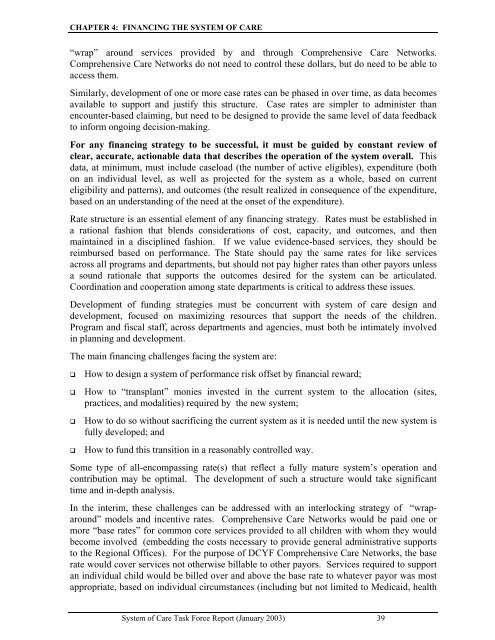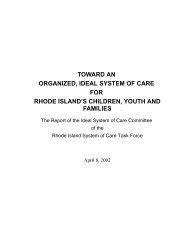Final Report - RI Department of Children, Youth & Families
Final Report - RI Department of Children, Youth & Families
Final Report - RI Department of Children, Youth & Families
Create successful ePaper yourself
Turn your PDF publications into a flip-book with our unique Google optimized e-Paper software.
CHAPTER 4: FINANCING THE SYSTEM OF CARE<br />
“wrap” around services provided by and through Comprehensive Care Networks.<br />
Comprehensive Care Networks do not need to control these dollars, but do need to be able to<br />
access them.<br />
Similarly, development <strong>of</strong> one or more case rates can be phased in over time, as data becomes<br />
available to support and justify this structure. Case rates are simpler to administer than<br />
encounter-based claiming, but need to be designed to provide the same level <strong>of</strong> data feedback<br />
to inform ongoing decision-making.<br />
For any financing strategy to be successful, it must be guided by constant review <strong>of</strong><br />
clear, accurate, actionable data that describes the operation <strong>of</strong> the system overall. This<br />
data, at minimum, must include caseload (the number <strong>of</strong> active eligibles), expenditure (both<br />
on an individual level, as well as projected for the system as a whole, based on current<br />
eligibility and patterns), and outcomes (the result realized in consequence <strong>of</strong> the expenditure,<br />
based on an understanding <strong>of</strong> the need at the onset <strong>of</strong> the expenditure).<br />
Rate structure is an essential element <strong>of</strong> any financing strategy. Rates must be established in<br />
a rational fashion that blends considerations <strong>of</strong> cost, capacity, and outcomes, and then<br />
maintained in a disciplined fashion. If we value evidence-based services, they should be<br />
reimbursed based on performance. The State should pay the same rates for like services<br />
across all programs and departments, but should not pay higher rates than other payors unless<br />
a sound rationale that supports the outcomes desired for the system can be articulated.<br />
Coordination and cooperation among state departments is critical to address these issues.<br />
Development <strong>of</strong> funding strategies must be concurrent with system <strong>of</strong> care design and<br />
development, focused on maximizing resources that support the needs <strong>of</strong> the children.<br />
Program and fiscal staff, across departments and agencies, must both be intimately involved<br />
in planning and development.<br />
The main financing challenges facing the system are:<br />
! How to design a system <strong>of</strong> performance risk <strong>of</strong>fset by financial reward;<br />
! How to “transplant” monies invested in the current system to the allocation (sites,<br />
practices, and modalities) required by the new system;<br />
! How to do so without sacrificing the current system as it is needed until the new system is<br />
fully developed; and<br />
! How to fund this transition in a reasonably controlled way.<br />
Some type <strong>of</strong> all-encompassing rate(s) that reflect a fully mature system’s operation and<br />
contribution may be optimal. The development <strong>of</strong> such a structure would take significant<br />
time and in-depth analysis.<br />
In the interim, these challenges can be addressed with an interlocking strategy <strong>of</strong> “wraparound”<br />
models and incentive rates. Comprehensive Care Networks would be paid one or<br />
more “base rates” for common core services provided to all children with whom they would<br />
become involved (embedding the costs necessary to provide general administrative supports<br />
to the Regional Offices). For the purpose <strong>of</strong> DCYF Comprehensive Care Networks, the base<br />
rate would cover services not otherwise billable to other payors. Services required to support<br />
an individual child would be billed over and above the base rate to whatever payor was most<br />
appropriate, based on individual circumstances (including but not limited to Medicaid, health<br />
System <strong>of</strong> Care Task Force <strong>Report</strong> (January 2003) 39
















